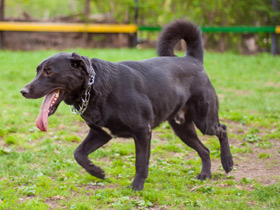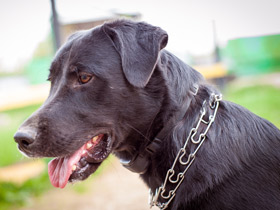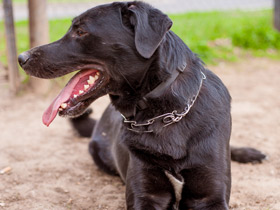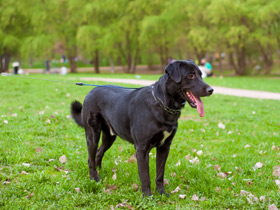The dog or domestic dog (Canis familiaris or Canis lupus familiaris)
The dog (Canis familiaris or Canis lupus familiaris) is a domesticated descendant of the wolf. Also called the domestic dog, it is derived from extinct Pleistocene wolves, and the modern wolf is the dog's nearest living relative. The dog was the first species to be domesticated by humans. Hunter-gatherers did this, over 15,000 years ago in Oberkassel, Bonn, which was before the development of agriculture. Due to their long association with humans, dogs have expanded to a large number of domestic individuals and gained the ability to thrive on a starch-rich diet that would be inadequate for other canids.
The dog has been selectively bred over millennia for various behaviors, sensory capabilities, and physical attributes. Dog breeds vary widely in shape, size, and color. They perform many roles for humans, such as hunting, herding, pulling loads, protection, assisting police and the military, companionship, therapy, and aiding disabled people. Over the millennia, dogs became uniquely adapted to human behavior, and the human–canine bond has been a topic of frequent study. This influence on human society has given them the sobriquet of "man's best friend".
Taxonomy
In 1758, the Swedish botanist and zoologist Carl Linnaeus published in his Systema Naturae, the two-word naming of species (binomial nomenclature). Canis is the Latin word meaning "dog", and under this genus, he listed the domestic dog, the wolf, and the golden jackal. He classified the domestic dog as Canis familiaris and, on the next page, classified the grey wolf as Canis lupus. Linnaeus considered the dog to be a separate species from the wolf because of its upturning tail (cauda recurvata), which is not found in any other canid.
In 1999, a study of mitochondrial DNA (mtDNA) indicated that the domestic dog may have originated from the grey wolf, with the dingo and New Guinea singing dog breeds having developed at a time when human communities were more isolated from each other. In the third edition of Mammal Species of the World published in 2005, the mammalogist W. Christopher Wozencraft listed under the wolf Canis lupus its wild subspecies and proposed two additional subspecies, which formed the domestic dog clade: familiaris, as named by Linnaeus in 1758 and, dingo named by Meyer in 1793. Wozencraft included hallstromi (the New Guinea singing dog) as another name (junior synonym) for the dingo. Wozencraft referred to the mtDNA study as one of the guides informing his decision. Mammalogists have noted the inclusion of familiaris and dingo together under the "domestic dog" clade with some debating it.
In 2019, a workshop hosted by the IUCN/Species Survival Commission's Canid Specialist Group considered the dingo and the New Guinea singing dog to be feral Canis familiaris and therefore did not assess them for the IUCN Red List of Threatened Species.
Origin
Domestic dog is a carnivorous mammal of the canid family, which is a species of the genus Canis.
There is no doubt that the dog was the first animal domesticated by man. But exactly when and how this happened is a matter of constant debate.
At first, scientists believed that as a species Canis familiaris was formed 10-12 thousand years ago. Later, taking into account the available archaeological data, the time interval of its domestication shifted to between 11500 and 16300 years, and the possibility of its repeated domestication was suggested.
More recent data have allowed further adjustments to be made to the question of dog domestication:
Scientists from Novosibirsk have co-authored a major paper by an international team of researchers that elucidates the origins of domestic dogs and has been placed on the cover of the renowned scientific journal Science. The study focuses on an ancient dog found by Siberians in the Altai Mountains. It has also been revealed that today's wolves are no longer direct relatives of domestic dogs.
An article entitled Complete Mitochondrial Genomes of Ancient Canids Suggest a European Origin of Domestic Dogs was published on 15 November on the cover of the latest issue of Science, one of the world's most respected scientific journals.
The article was written by a large team of scientists from Finland, the United States, Germany, Spain, Belgium, Argentina and Russia. Co-authors include Alexander Grafodatsky, deputy director of scientific work at the Novosibirsk Institute of Molecular and Cell Biology, and Nikolai Ovod, senior researcher at the Institute of Archaeology and Ethnography of the Siberian Branch of the Russian Academy of Sciences.
As the paper's preface notes, the geographical and temporal points of origin of the domestic dog have remained controversial: early genetic evidence suggested that domestication began in East Asia 15,000 years ago (similar to sheep, goats and other livestock) at the time of the human transition to sedentism, while canine bones from Europe and Siberia date back 30,000 years.
"We have analysed the mitochondrial genomes of 18 prehistoric canines from Eurasia and the New World, compared to modern dogs and wolves. The mitochondrial genomes of all modern dogs are phylogenetically most closely related to ancient or modern European canines," the genetics team announces in the preface.
However, the text of the article itself complicates the picture, co-author Alexander Grafodatsky told Sib.fm.
"The most prominent ancient dog among those found is the one found in the Razboichya cave in Altai," Grafodatsky said, "earlier this year we read part of its mitochondrial genome, and now the whole genome. And what came out in the end: the dogs were probably domesticated many times, and not by people who became sedentary, but by hunters and gatherers who followed the receding glaciers. And dogs were constantly interbreeding with wolves, because the species is one and the same, and they constantly confuse the picture.
As a result, the Altai dog (its remains were found in the Razboinichya cave in 1975 by Nikolay Ovodov, a member of the Institute of Archaeology and Ethnography of the Siberian Branch of the Russian Academy of Sciences, second Siberian co-author of the Science article) became the "number one star", as its genes were discovered in the genes of European dogs between 10,000 and 15,000 years later.
"It turns out that we found relatives of our canid among the ancient wolves of Europe, later than our dog, and in two modern breeds, the exotic barking dogs of northern Scandinavia," the researcher said.
One more conclusion can be drawn from this history: all wolves that were ancestors of modern dogs are now extinct. And they are much more distant from modern wolves.
Description and peculiarities
It is difficult to say how many dog breeds exist in the world today. The International Canine Association now officially recognises about four hundred and fifty breeds, and the number is constantly increasing. The appearance and size of the different dog breeds varies greatly. The largest dogs are the Irish Wolfhound and the Neapolitan Mastiff. The former has a height at the withers of about 80 cm and a weight of more than 100 kg. The smallest dog, the Chihuahua, weighs between 200 and 300 grams and measures only 13 cm at the withers.
Numerous special breeds of dog are used for various purposes: hunting, protection, transport, etc., as well as decorative breeds.
Breeding work continues and more and more dogs are being developed, such as rescue dogs, guide dogs and dogs trained to find drugs or explosives...
Classification according to the FCI
The Fédération Cynologique Internationale (FCI) classifies dogs into ten main groups according to their function and characteristics.
- sighthounds;
- retrievers and hounds for hunting and water dogs;
- companion dogs;
- Pointing dogs;
- Sheepdogs and Cattle Dogs (except Swiss Cattle Dogs);
- pinscher and schnauzer type dogs - Molossoids - mountain dogs and Swiss Cattle Dogs;
- hounds, scent hounds and similar breeds;
- spitz and primitive type dogs;
- teckels;
- terriers.
Breed types
- bichon (Maltese bichon, bichon frise);
- Braco (German Shorthaired Braco, Weimar Braco);
- Bulldog (English bulldog, American bulldog);
- collie (border collie, long-haired collie);
- cur (catahoula);
- dogo (dogo argentino, dogo español);
- Feist (American toy terrier);
- griffon (korthals griffon);
- sighthounds (Spanish greyhound, azawakh);
- mastiff (mucuchíes, Tibetan Mastiff);
- retriever (golden retriever, Labrador retriever);
- water retriever (Newfoundland, St. Bernard, St. Bernard);
- perro pila (Argentinian pila dog);
- perro de agua (Spanish water dog);
- pinscher (doberman pinscher, German pinscher);
- podenco (Portuguese podenco, Andalusian podenco);
- ratonero (Andalusian Bodeguero Bodeguero Bodeguero);
- hound (basset hound, bloodhound);
- Setter (Gordon Setter, English Setter);
- spaniel (English cocker spaniel);
- Spitz (husky, Alaskan malamute);
- terrier (airedale terrier, fox terrier).



















































